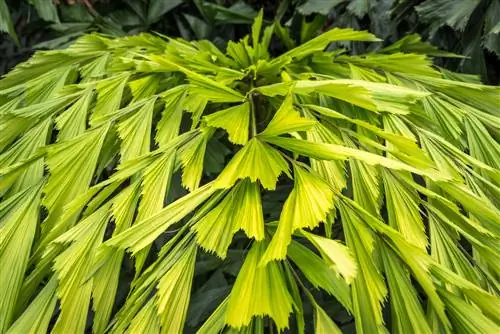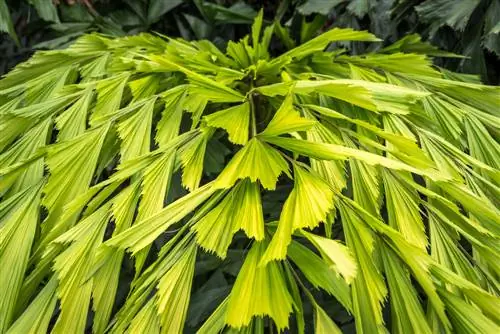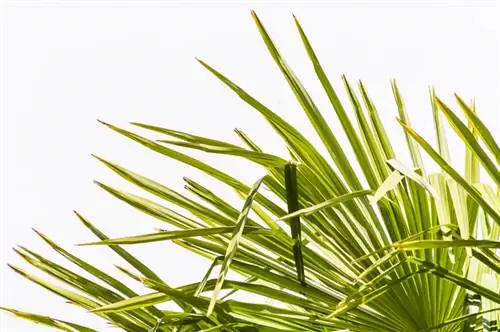- Author admin [email protected].
- Public 2023-12-16 16:46.
- Last modified 2025-01-23 11:21.
The fishtail palm (Caryota mitis), with its lush, fresh green foliage in the shape of a fishtail, is a demanding but at the same time very attractive palm with manageable dimensions. Unlike other exotic houseplants such as the cactus spurge, the fishtail palm is non-toxic as long as it is not intended for consumption.

How do I properly care for a fishtail palm?
Caring for a fishtail palm (Caryota mitis) includes regular watering without waterlogging, repotting every few years, removing wilted leaves, pest control, adjusting the humidity and fertilizing with palm fertilizer during the growth phase. Also ensure ideal location conditions and winter protection.
What should you consider when watering a Caryota mitis?
The fishtail palm should never dry out completely and should therefore be watered regularly as soon as the substrate on the surface has dried slightly. However, the water should be dosed so that no excess water remains in the coaster.
Does the fishtail palm need to be repotted annually?
The fishtail palm only needs to be repotted every few years. It is even the case that this type of palm tree sometimes shows stronger growth when there is little space in the plant pot than in a plant pot that is too large. In the lower quarter of the plant pot, shards of pottery or a similarly coarse material can be placed to prevent waterlogging.
Can the fishtail palm be cut back?
When removing wilted leaves, you should not cut too close to the trunk, but leave a stub about 3 to 5 cm long. The natural habitus of the fishtail palm does not actually require any pruning measures. Side shoots can be carefully removed for propagation purposes.
How to control pests on a Caryota mitis?
The fishtail palm, like the cactus spurge and other plants from warmer regions of the earth, is often attacked by spider mites when cared for as a houseplant. Since these pests rely on a dry climate, frequent spraying with water may be sufficient as a prevention and control measure. You should also regularly check the fishtail palm for an infestation of thrips, otherwise they will multiply quickly and can be responsible for the leaves dying.
What to do if the fishtail palm shows symptoms of disease?
Dried out leaf tips or leaves that have dried out as a whole can be due not only to infrequent watering, but also to low humidity. Yellow-colored leaves, on the other hand, can indicate a location that is either too sunny or too dark.
How should you fertilize the fishtail palm?
During the summer months, Caryota mitis is supplied monthly with a special palm fertilizer (€7.00 on Amazon). If this palm is cultivated indoors at consistently warm temperatures all year round, a low dose of fertilizer can be applied approximately every two months in winter.
Under what conditions is a Caryota mitis ideally overwintered?
Planted specimens of the fishtail palm can survive short-term frost temperatures of up to minus 7 degrees Celsius with a certain amount of winter protection and after appropriate acclimatization. However, if the fishtail palm is kept indoors over the winter, the following site conditions should be observed:
- as bright as possible
- less fertilizer and water than in the light summer
- increase the humidity by using water bowls or containers with moist peat next to the fishtail palm
Tip
In most cases, you will not see the beautiful seeds of the fishtail palm if you grow them indoors. You can also propagate this type of palm tree by removing the side shoots that sometimes form.






